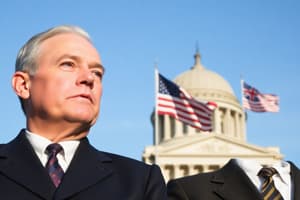Podcast
Questions and Answers
Who was the president of the United States from 1945 to 1953?
Who was the president of the United States from 1945 to 1953?
- Harry S. Truman (correct)
- Lyndon B. Johnson
- Dwight D. Eisenhower
- Franklin D. Roosevelt
What was the Bretton Woods Conference?
What was the Bretton Woods Conference?
A meeting of Western allies to establish a postwar international economic order.
What organization was established to encourage world trade by regulating currency exchange rates?
What organization was established to encourage world trade by regulating currency exchange rates?
- United Nations
- World Bank
- World Trade Organization
- International Monetary Fund (correct)
What is the purpose of the World Bank?
What is the purpose of the World Bank?
What major event did the Berlin Airlift respond to?
What major event did the Berlin Airlift respond to?
The Berlin Wall was erected in 1961 as a symbol of division between communist and capitalist worlds.
The Berlin Wall was erected in 1961 as a symbol of division between communist and capitalist worlds.
What was the foundation of the Containment Doctrine?
What was the foundation of the Containment Doctrine?
What was the purpose of the Truman Doctrine?
What was the purpose of the Truman Doctrine?
What did the Marshall Plan aim to achieve?
What did the Marshall Plan aim to achieve?
Which act established the National Security Council?
Which act established the National Security Council?
McCarthyism refers to rational beliefs about people being communists.
McCarthyism refers to rational beliefs about people being communists.
The ____ was a military alliance of Western European powers and the US to defend against Soviet threats.
The ____ was a military alliance of Western European powers and the US to defend against Soviet threats.
What significant change did the Executive Order 9981 bring?
What significant change did the Executive Order 9981 bring?
What did the Taft-Hartley Act outlaw?
What did the Taft-Hartley Act outlaw?
What was the main cause of the decline of unions during this time?
What was the main cause of the decline of unions during this time?
What was the 'Point Four' program?
What was the 'Point Four' program?
What does the term 'Sunbelt' refer to?
What does the term 'Sunbelt' refer to?
What was the Baby Boom?
What was the Baby Boom?
Flashcards are hidden until you start studying
Study Notes
President Truman
- Served as president from 1945 to 1953; assumed office unexpectedly.
- Known for loyalty to his associates from Missouri ("MO gang").
- Exhibited a mix of confidence and hot temper in leadership.
Tensions between US and USSR
- Diverging visions for a post-war world fueled conflicts.
- Fundamental ideological clash between Communism and Democracy.
Bretton Woods Conference (July 1944)
- Convened to set up a stable international economic framework post-WWII.
- Resulted in the establishment of the International Monetary Fund and the World Bank.
International Monetary Fund
- Created to promote global trade by stabilizing currency exchange rates.
World Bank
- Tasked with providing economic aid to developing and struggling nations.
North Atlantic Treaty Organization (NATO) (1949)
- Military alliance including Western European nations, the US, and Canada.
- Aimed to counter Soviet threats, enhancing transatlantic unity.
Warsaw Pact
- Formation of a military alliance by the Soviet Union in response to NATO.
Berlin Blockade
- A reaction to the unification of West Germany’s currency; USSR halted access to West Berlin.
Berlin Airlift (1948-1949)
- Year-long operation to deliver supplies to West Berlin citizens during the Soviet blockade.
Containment Doctrine
- Strategy to prevent Soviet expansion through diplomatic, military, and economic means.
Truman Doctrine
- Commitment to support nations resisting Communism, notably with $400 million for Greece and Turkey.
Marshall Plan (1948)
- Significant financial aid program aimed at rebuilding Western Europe to deter communism.
National Security Act of 1947
- Created the National Security Council and Central Intelligence Agency (CIA) to manage foreign policies.
Korean War (1950-1953)
- Conflict between North and South Korea, influenced by China and the Soviet Union, ending in division at the 38th parallel.
Executive Order 9981
- Mandated the desegregation of the U.S. armed forces.
Loyalty Review Board
- Investigated loyalty of around 3 million federal employees during the Red Scare.
Smith Act (1940)
- First peacetime anti-sedition law; upheld in Dennis v. US case.
House Committee on Un-American Activities (HUAC)
- Investigated and prosecuted suspected communists, including former Senator Alger Hiss.
McCarthyism
- Phenomenon characterized by irrational fears and accusations regarding communism.
Taft-Hartley Act (1947)
- Amended the Wagner Act to limit union powers and required union leaders to declare anti-communist sentiments.
Decline of Unions
- Several factors led to union decline: division due to racism, inability to organize southern workers, and labor outsourcing.
Fair Deal (1949)
- Initiatives by Truman aimed at social reforms, including wage raises and public housing development.
Era of Affluence (1950-1970)
- Marked by economic growth, doubling of national income, and creation of the American Dream narrative.
Roots of Postwar Prosperity
- Key factors included military spending, inexpensive energy, improved worker productivity, and agricultural growth.
Sunbelt
- A thriving region from Virginia to California, attracting residents for its favorable climate and employment opportunities.
Suburbia
- The rise of suburban living exemplified by Levittown, marking a significant shift in American residential patterns.
White Flight
- Racial dynamics where white residents moved out as neighborhoods became more racially integrated.
Baby Boom
- A demographic surge post-WWII, resulting in over 50 million births by 1950; had lasting impacts on resources and society.
Studying That Suits You
Use AI to generate personalized quizzes and flashcards to suit your learning preferences.





